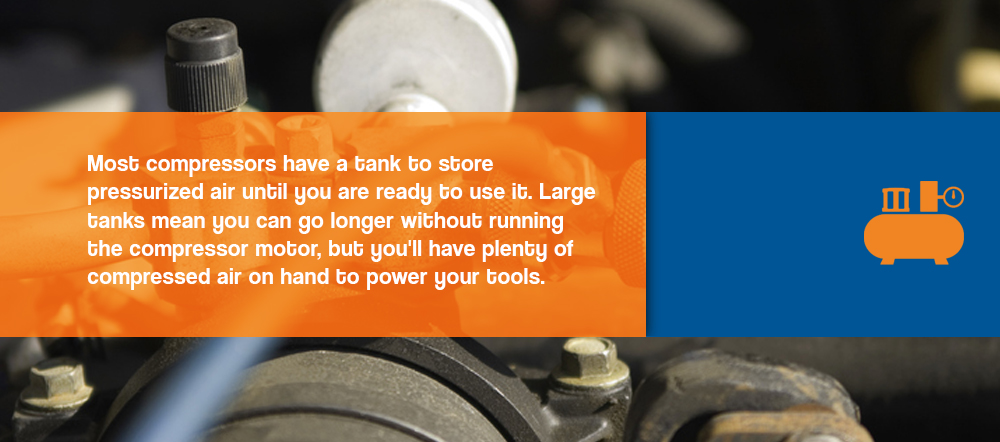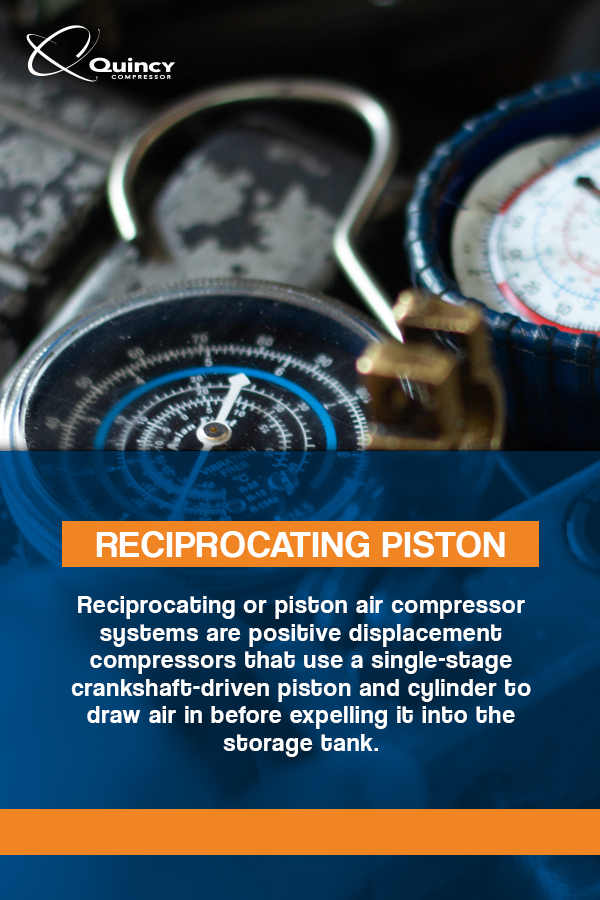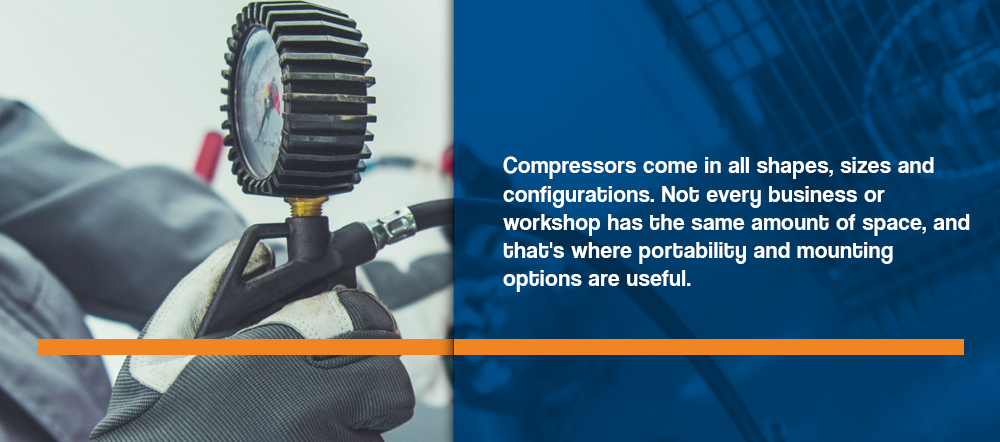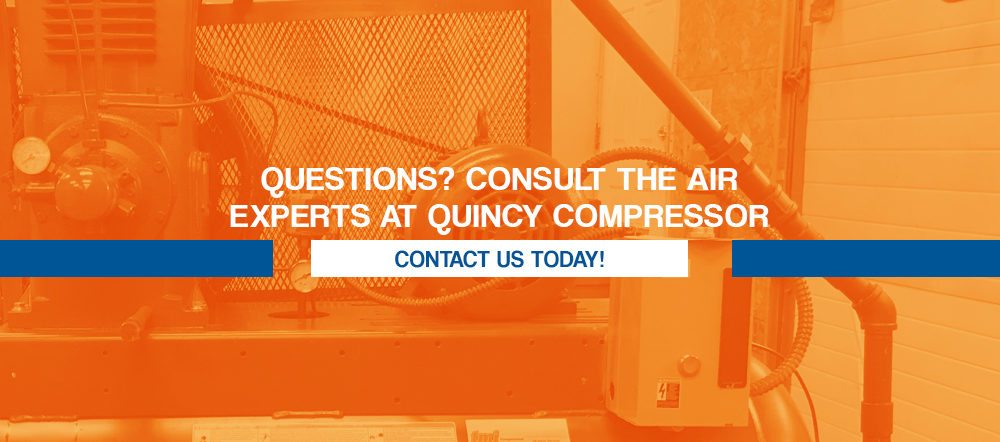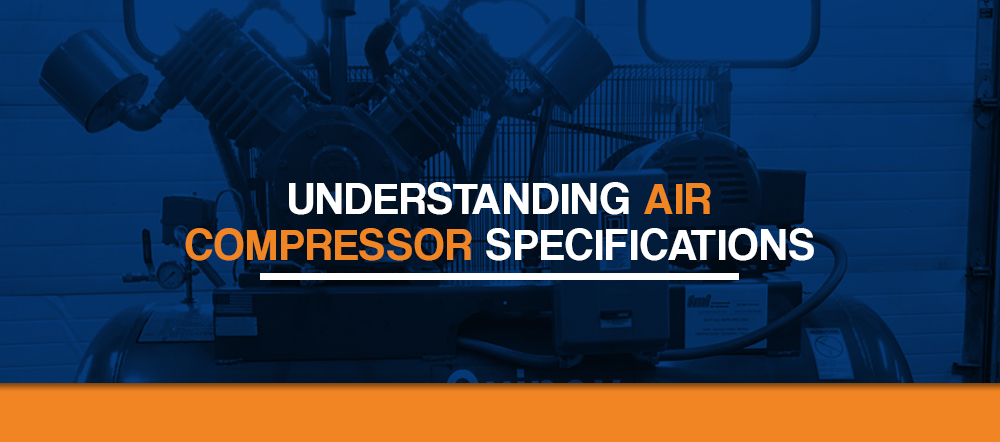
There are many essential factors to consider when selecting a compressor, including:
- The pounds per square inch gauge (PSIG)
- Cubic feet per minute (CFM)
- Horsepower
- Size of the tank
- The duty cycle
- The type of motor it uses
- Lubricated vs. oil-free systems
- Rotary screw vs. reciprocating/piston systems
- Air treatment options
- Required piping.
You’ll also need to think about whether regulation is required, what kind of cooling features you need and which mounting options make the most sense for your workspace.
As you review different compression systems, various specifications and other data, you may encounter terminology with which you are unfamiliar. To make things easier, Qunicy Compressor has compiled a list of different air compressor specifications and what those specifications mean.
Air Compressor Specs: Here’s What You Need to Know
Although they all perform the same function — transforming intake air into filtered, compressed air — there are several different types of air compressors, systems and additional features to consider. Choosing the right air compressor for your business or workshop means navigating the different air compressor specs to make an informed decision.
Whether you are a hobbyist seeking an air compressor for your home garage or a business owner implementing compressed air into your industrial processes, here is a brief rundown of some of the most commonly cited facts, figures and configurations, and what they mean:
1. Pressure and PSIG
An air compressor’s primary goal is to pressurize intake air for various industrial processes. The ability of a compressor to pressurize air is measured in pounds per square inch gauge, or PSIG, which is a comparison of the pressure inside the tank and the barometric pressure. Barometric pressure is the amount of air pressure in the atmosphere.
Most pneumatic tools require 90 PSIG to operate, but some heavy-duty tools and applications will need more. You should always check the manufacturer’s listed PSI or PSIG requirements for your device or end-product to avoid operating with too little or too much power.
2. Capacity and CFM
The capacity of an air compressor is the amount of air it can produce at a specific PSIG. This output capacity is measured in cubic feet per minute, or CFM.
Capacity is one of the most significant air compressor purchase factors, especially if you intend to run multiple tools at once. When calculating the required CFM, you should consider the pressure level you need and if you plan to use your compressed air continuously or sporadically.
For example, high-pressure tools that require constant or near-constant airflow need a higher capacity air compressor. For machines that use short bursts of air, such as a nail gun, a lower capacity is suitable. You may need more than one air compressor for industries that require multiple capacities.
3. Horsepower
All compressors have an engine and motor component. That motor drives a crankshaft which moves pistons that produce the compressed air through an intricate mechanical process. As with automotive engines, we measure the amount of work the motor can perform in horsepower. One horsepower is equal to 550 foot-pounds per second, or 745.7 watts.
When it comes to air compressors, however, horsepower is not as straightforward as it is when considering the power of a new car or truck. It should be one of several air compressor purchase factors you consider. While a minimum amount of air compressor horsepower is required to deliver specific levels of pressure or capacity, many compressors are overpowered and inefficient. A well-designed compressor should be able to produce four CFM at 100 PSIG for every unit of power.
4. Tank Size
Most compressors have a tank to store pressurized air until you are ready to use it. Large tanks mean you can go longer without running the compressor motor, but you’ll have plenty of compressed air on hand to power your tools. Because your compressor is running less, you may see cost savings reflected in your energy bill.
The best place to start is a minimum of five gallons of storage space per CFM.
5. Duty Cycle
An air compressor’s duty cycle is the amount of time it can operate before it needs to shut down. The duty cycle is expressed as a percentage.
For example, a compressor with a 15 percent duty cycle would need eight-and-a-half minutes of downtime for every one-and-a-half minutes of run time. An air compressor with a 25 percent duty cycle would run for one-fourth of the total cycle time. Compressors with low run times such as these are ideal for small applications or tools and are not typically used in an industrial environment.
Heavy-duty compressors usually have a duty cycle of 35 percent or higher, including air compressors with 50 and 75 percent duty cycle. Heavy-duty cycles are suitable for workshops, garages and some high-demand tools. Compressors with a 100 percent duty cycle are “ultimate duty,” and their engines contain cooling components to prevent overheating. Ultimate duty air compressors are used in industry or factory environments because they can keep up with the constant demand of highly compressed air.
6. Motor Type
Most air compressors operate using standard, three-face induction motors. They are typically powered by electricity, diesel or natural gas. Electric motors are reliable, economical and capable of generating enough power for standard use at home or around your workshop or garage.
Gas-powered compressors, on the other hand, tend to be more powerful and offer the convenience of portability. You should choose an air compressor that fits with your personal or business needs. To determine which type is best for your applications, consider:
- Electricity costs
- Fuel availability
- Initial investment budget
- Portability
7. Lubrication
When an air compressor has movable parts, those components require lubrication to reduce wear-and-tear and prolong the machine’s life. Lubricated air compressors inject an oil-based solution into the compression chamber, which distributes it to the parts. These air compressors require an oil filter to keep residual oil out of the compressed air. For applications and industries that require 100 percent oil-free compressed air, there are oil-free compressors.
8. Rotary Screw
Rotary screw air compressor specifications refer to a positive displacement compression system powered by two counter-rotating helical screws, also called rotors. Air is trapped between these two rotors and that air decreases in volume as it moves, resulting in compressed air. Rotary screw compressor specifications include both lubricated and oil-free compressors, which are designed for prolonged use. Although rotary screw compressors are very durable and efficient, they require ongoing preventive maintenance by a trained professional for best results.
9. Reciprocating Piston
Reciprocating or piston air compressor systems are positive displacement compressors that use a single-stage crankshaft-driven piston and cylinder to draw air in before expelling it into the storage tank. These machines expel air using a single-piston stroke of approximately 120 pounds per square inch (PSI).
Two-stage reciprocating compressors implement a second step, where an additional, smaller piston brings the pressure up to around 175 PSI. These machines are simple to operate and require little ongoing maintenance, making them ideal for individuals using an air compressor in their home workshop or garage.
10. Multi-Stage Systems
Multi-stage systems are reciprocating or piston air compressors that compress and cool the air using more than one cylinder. Multi-stage compressors deliver high volumes of compressed air and can power more than one tool at a time. Because these systems are so efficient, they are often a very cost-effective compressed air method in the longterm. However, because this system has more components, expect a higher initial investment and less floor space.
11. Regulation
An air compressor’s regulator maintains a constant pressure in the compressed air, and it is crucial in industries that require air with no fluctuation. Pressure regulation is essential for larger HP units that don’t need to run at full capacity all the time. An air compressor pressure regulator prevents you from having to start and stop the motor continually. They are also ideal for energy conservation.
The two main types of regulators are:
- Load/no load control, which vents the unit when a given pressure is reached.
- Modulation control, which throttles the inlet plate, causing the machine to draw in less air.
You can also choose between a compressor with a manual or automatic regulator.
The pressure measurement displayed on your regulator gauge refers to the pressure level of the discharged air that enters your air hose from the tank. You can adjust this gauge to your required pressure level. Keep in mind that compressor regulators can only move the pressure level down and cannot raise the pressure inside your tank past its maximum output capacity.
12. Cooling Features
Cooling an air compressor is essential to preventing failure during continuous use. Cooling features are also critical for preventing overheating, which can be dangerous for both your compressor and those operating it. Air compressors can possess different types of cooling technologies, including:
- Heat exchangers
- Intercooling
- Diaphragm cooling
- Aftercooling
Many more types of cooling technologies exist besides the ones mentioned here. Some of these cooling methods use water, and some use air. Always choose cooling features designed for your size and type of air compressor. The type of cooling system you use will determine your machine’s maintenance schedule, especially if it’s open or closed. If you are unsure, contact an air compressor service professional.
13. Air Treatment
Instead of using raw compressed air, you can implement several air treatment options in your workspace, including air compressor filters, condensate management products and air dryers.
Air compressor filtration systems remove oil, particulates, dirt, debris and moisture from compressed air. These are essential in environments that require pure, contaminant-free compressed air for the quality of their end-products. You can choose from standard and high-pressure filters, as well as standalone mist eliminators.
Condensate management products include electronic and pneumatic drains, as well as condensate purifiers with disposable filters. Electronic, no loss drains are energy efficient and possess an optimum reservoir capacity, which saves you time and energy. Pneumatic, no loss drains also uphold energy efficiency by wasting no air and operating on demand. Alternatively, condensate purifiers are lightweight and use carbon-free filtering media to supplement the ease of their disposable filters.
You can use air dryers to remove excess moisture from your machine, as well as your compressed air. Otherwise, this moisture could damage your air compressor system, cause premature wear-and-tear on its inner mechanisms or contaminate compressed air. There are multiple types of air drying systems, but the two most popular are refrigerated and desiccant dryers.
14. Air Compressor Piping
Air compressor piping connects your air compressor to all the devices that use its energy. High-quality piping and professional installation are crucial for sufficient air movement. There are several things to consider when implementing your piping system, including layout considerations, pipe material and more. For example, sharp angles in your piping can impede airflow, increase turbulence and cause three to five pounds per square inch differential (PSID) of pressure loss.
15. Mounting Options
Compressors come in all shapes, sizes and configurations. Not every business or workshop has the same amount of space, and that’s where portability and mounting options are useful. You can choose a portable or stationary air compressor, or you can opt for a trailer-mounted system. Choose a configuration that allows you the most flexibility and makes sense for your work environment. However, be aware that the larger your model, the more power you will require.
Always check that your power supply is adequate before making your final purchase. You should also be sure not to mount an electric compressor too far from the power source. Always install your compressor in a well-ventilated, spacious area and do not allow it to press against walls or other objects while in use.
16. Efficiency
Your air compressor’s efficiency refers to how well it operates, how it minimizes energy waste and how effectively it compresses high-quality air. You can implement several practices to maximize your compressor’s efficiency. For example, you can take steps to improve your workspace’s air quality, including the air’s cleanliness and humidity level. You can also choose to invest in high-quality equipment designed to last a long time.
Questions? Consult the Air Experts at Quincy Compressor
Although air compressors are easy enough to use, they can be some of the most complex pieces of machinery in your workplace. Since the 1920s, Quincy Compressor has been dedicated to helping consumers stay informed about the products they choose and crafting machinery — including air compressors, air dryers and other compressed air equipment — that deliver uncompromising reliability and performance.
If you have additional questions about air compressor specs or want to learn more about the various compressor options available to you, contact a knowledgable Quincy Compressor representative for assistance or use our sales and service locator to find a dealer near you.


